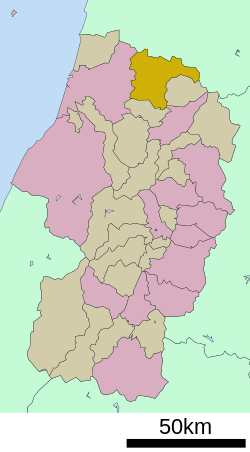|
Mamurogawa
 Mamurogawa (真室川町, Mamurogawa-machi) is a town located in Yamagata Prefecture, Japan. As of 31 March 2023[update], the town has an estimated population of 6,792 in 2560 households,[1] and a population density of 18 persons per km². The total area of the town is 374.22 square kilometres (144 sq mi). GeographyMamurogawa is located in the northern portion of the Shinjō Basin in north-central Yamagata Prefecture. The basin is surrounded on all sides by low mountains, with the Ōu Mountains to the northeast and the Dewa Mountains running from the west to the north. The area is known for its heavy snowfalls in winter. Neighboring municipalitiesAkita Prefecture Yamagata Prefecture ClimateMamurogawa has a humid continental climate (Köppen climate classification Cfa) with large seasonal temperature differences, with warm to hot (and often humid) summers and cold (sometimes severely cold) winters. Precipitation is significant throughout the year, but is heaviest from August to October. The average annual temperature in Mamurogawa is 10.2 °C (50.4 °F). The average annual rainfall is 2,810.9 mm (110.67 in) with July as the wettest month. The temperatures are highest on average in August, at around 23.2 °C (73.8 °F), and lowest in January, at around −1.0 °C (30.2 °F).[2]
DemographicsPer Japanese census data,[4] the population of Mamurogawa peaked in the 1950s and has declined by more than half since then. It is now less than it was a century ago.
HistoryThe area of present-day Mamurogawa was part of ancient Dewa Province and the location of Sakenobe Castle in the Sengoku period. After the start of the Meiji period, the area became part of Mogami District, Yamagata Prefecture. The village of Mamurogawa was established on April 1, 1889 with the establishment of the modern municipalities system. During World War II, an airbase for training pilots was established by the Imperial Japanese Army. The site is now a park, and part of the grounds of the local high school. Mamurogawa was elevated to town status on April 1, 1950. On August 1, 1954, it absorbed the neighboring villages of Araki and Nozoki. EconomyThe economy of Mamurogawa is based on agriculture and forestry. The main crops are rice and tara-no-me, a spring herb. EducationMamurogawa has three public elementary schools and one public middle school operated by the town government and one public high school operated by the Yamagata Prefectural Board of Education. TransportationRailway
Highway
Local attractions
Notes
External links
|
|||||||||||||||||||||||||||||||||||||||||||||||||||||||||||||||||||||||||||||||||||||||||||||||||||||||||||||||||||||||||||||||||||||||||||||||||||||||||||||||||||||||||||||||||||||||||||||||||||||||||||||||||||||||||||||||||||||||||||||||||||||||||





